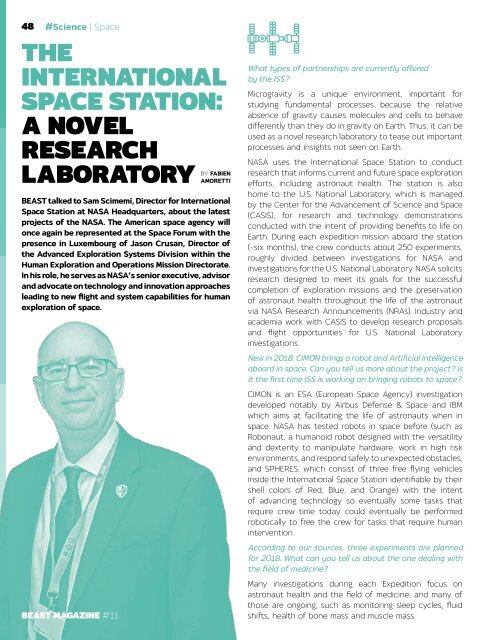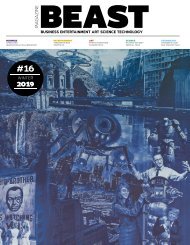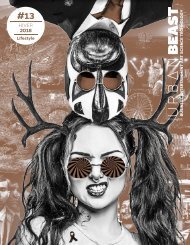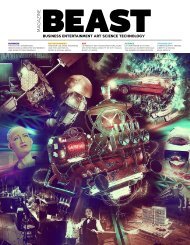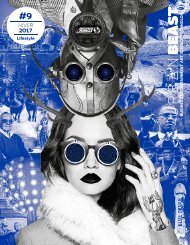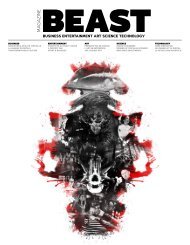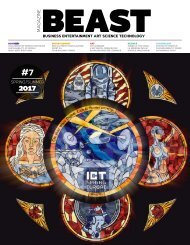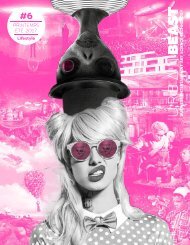Magazine_BEAST_2018_Edition_11_complet.compressed
You also want an ePaper? Increase the reach of your titles
YUMPU automatically turns print PDFs into web optimized ePapers that Google loves.
48 #Science | Space<br />
THE<br />
INTERNATIONAL<br />
SPACE STATION:<br />
A NOVEL<br />
RESEARCH<br />
BY<br />
LABORATORY<br />
FABIEN<br />
AMORETTI<br />
<strong>BEAST</strong> talked to Sam Scimemi, Director for International<br />
Space Station at NASA Headquarters, about the latest<br />
projects of the NASA. The American space agency will<br />
once again be represented at the Space Forum with the<br />
presence in Luxembourg of Jason Crusan, Director of<br />
the Advanced Exploration Systems Division within the<br />
Human Exploration and Operations Mission Directorate.<br />
In his role, he serves as NASA’s senior executive, advisor<br />
and advocate on technology and innovation approaches<br />
leading to new flight and system capabilities for human<br />
exploration of space.<br />
<strong>BEAST</strong> MAGAZINE #<strong>11</strong><br />
What types of partnerships are currently offered<br />
by the ISS?<br />
Microgravity is a unique environment, important for<br />
studying fundamental processes because the relative<br />
absence of gravity causes molecules and cells to behave<br />
differently than they do in gravity on Earth. Thus, it can be<br />
used as a novel research laboratory to tease out important<br />
processes and insights not seen on Earth.<br />
NASA uses the International Space Station to conduct<br />
research that informs current and future space exploration<br />
efforts, including astronaut health. The station is also<br />
home to the U.S. National Laboratory, which is managed<br />
by the Center for the Advancement of Science and Space<br />
(CASIS), for research and technology demonstrations<br />
conducted with the intent of providing benefits to life on<br />
Earth. During each expedition mission aboard the station<br />
(~six months), the crew conducts about 250 experiments,<br />
roughly divided between investigations for NASA and<br />
investigations for the U.S. National Laboratory. NASA solicits<br />
research designed to meet its goals for the successful<br />
<strong>complet</strong>ion of exploration missions and the preservation<br />
of astronaut health throughout the life of the astronaut<br />
via NASA Research Announcements (NRAs). Industry and<br />
academia work with CASIS to develop research proposals<br />
and flight opportunities for U.S. National Laboratory<br />
investigations.<br />
New in <strong>2018</strong>: CIMON brings a robot and Artificial Intelligence<br />
aboard in space. Can you tell us more about the project? Is<br />
it the first time ISS is working on bringing robots to space?<br />
CIMON is an ESA (European Space Agency) investigation<br />
developed notably by Airbus Defense & Space and IBM<br />
which aims at facilitating the life of astronauts when in<br />
space. NASA has tested robots in space before (such as<br />
Robonaut, a humanoid robot designed with the versatility<br />
and dexterity to manipulate hardware, work in high risk<br />
environments, and respond safely to unexpected obstacles,<br />
and SPHERES, which consist of three free flying vehicles<br />
inside the International Space Station identifiable by their<br />
shell colors of Red, Blue, and Orange) with the intent<br />
of advancing technology so eventually some tasks that<br />
require crew time today could eventually be performed<br />
robotically to free the crew for tasks that require human<br />
intervention.<br />
According to our sources, three experiments are planned<br />
for <strong>2018</strong>. What can you tell us about the one dealing with<br />
the field of medicine?<br />
Many investigations during each Expedition focus on<br />
astronaut health and the field of medicine, and many of<br />
those are ongoing, such as monitoring sleep cycles, fluid<br />
shifts, health of bone mass and muscle mass.


